|
Ferrari F430
Debut: 2005
Maker: Ferrari
Predecessor: 360 Modena
|
|
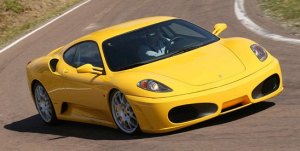 Being
beautiful, fast and soulful, Ferrari 360 Modena was my dream car for
the
past few years. With 17,000 cars sold from 1999 to 2004, it was also
the
most successful Ferrari in history. However, in the latter half of its
life it faced stiff competitions, first from Porsche 996 Turbo, then
Lamborghini
Gallardo and Ford GT. Compare with the Ferrari, they are even faster
and
handled better, if not as entertaining to drive. Commercially, the
Ferrari's
sales was never threatened by these competitors, thanks to its superior
brand image. But to maintain this superior image, Ferrari must do
something
to reverse the situation, otherwise sooner or later it will lose the
top
spot. It's time to strike back... Being
beautiful, fast and soulful, Ferrari 360 Modena was my dream car for
the
past few years. With 17,000 cars sold from 1999 to 2004, it was also
the
most successful Ferrari in history. However, in the latter half of its
life it faced stiff competitions, first from Porsche 996 Turbo, then
Lamborghini
Gallardo and Ford GT. Compare with the Ferrari, they are even faster
and
handled better, if not as entertaining to drive. Commercially, the
Ferrari's
sales was never threatened by these competitors, thanks to its superior
brand image. But to maintain this superior image, Ferrari must do
something
to reverse the situation, otherwise sooner or later it will lose the
top
spot. It's time to strike back...
Design and
Aerodynamics
So, here comes
the new F430.
Externally, it looks like a facelift of 360 Modena. Basically, all the
critical dimensions are unchanged, such as wheelbase, width, height and
tracks. Thankfully, the sexy shape of 360 Modena also retains.
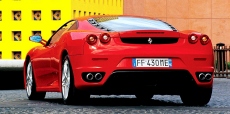 Based
on the beautiful design of 360, Pininfarina and Ferrari design chief
Frank
Stephenson injected more aggressiveness, such as a pair of vertical
headlamps,
Enzo-style half-recessed taillights, big oval front intakes (inspired
by
Ferrari 156 Grand Prix car of the early 60s), additional ventilation
holes
here and there... most of these modifications are driven by functions
rather
than art, but Ferrari once again proved that beautiful designs and
functions
are not mutually exclusive. Based
on the beautiful design of 360, Pininfarina and Ferrari design chief
Frank
Stephenson injected more aggressiveness, such as a pair of vertical
headlamps,
Enzo-style half-recessed taillights, big oval front intakes (inspired
by
Ferrari 156 Grand Prix car of the early 60s), additional ventilation
holes
here and there... most of these modifications are driven by functions
rather
than art, but Ferrari once again proved that beautiful designs and
functions
are not mutually exclusive.
The
tail of F430
incorporates
a larger diffuser. Together with other underbody aerodynamic tweaks, it
produces a lot more downforce than the already outstanding 360. For
example,
at 300km/h (186mph), it generates 280kg of downforce (130kg front,
150kg
rear), compare to the Modena's 195kg. Remember, this is achieved
without
seeking help from any external spoilers. At the same time, drag
coefficient
remains unchanged at 0.33.
Engine and
Performance
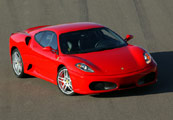 F430
might look like a facelifted 360, but underneath the familiar shape is
a vastly improved machine. A total of 70% parts are redesigned, most
notably
is the new 4.3-litre V8 engine. It produces 90 more horsepower than the
outgoing 3.6-litre V8, taking the total horsepower count to 490.
Astonishingly,
that’s more than the mighty F40, yet this is just the entry level
Ferrari
today ! F430
might look like a facelifted 360, but underneath the familiar shape is
a vastly improved machine. A total of 70% parts are redesigned, most
notably
is the new 4.3-litre V8 engine. It produces 90 more horsepower than the
outgoing 3.6-litre V8, taking the total horsepower count to 490.
Astonishingly,
that’s more than the mighty F40, yet this is just the entry level
Ferrari
today !
Ferrari claims
F430 can top
more than 196 mph, which we have no reasons to disbelieve. As for
acceleration,
despite of a weight increase of 60kg, F430 still boosts considerably
higher
power to weight ratio than its predecessor (338 hp/ton vs 288 hp/ton),
even beating Lamborghini Gallardo (329 hp/ton), if not Ford GT (357
hp/ton).
Ferrari claims it take only 3.95 seconds to sprint from zero to 60 mph,
9.2 seconds to 100 mph and 21.4 sec to 150 mph. This is also fully
trustable.
This means the Ferrari's performance at least matches Lamborghini
Gallardo.
Maybe marginally quicker.
Storming
performance aside,
drivers will praise the much improved tractability of the larger
capacity
V8. Not only maximum torque is increased from 275 lbft to 343 lbft at
5250
rpm, the engine now delivers serious punch from 3000 rpm upward. This
should
silent those criticized 360 Modena for lack of low-end grunt.
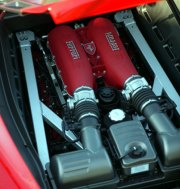 The
4308cc V8 is an all-new design instead of an evolution of the old V8,
whose
history can date back to the 348-era. It shares the basic aluminum
block
with Maserati’s 4.2-litre V8, with 1mm longer stroke accounting for the
increased capacity. Like the 360 engine, it runs a flat-plane
crankshaft
(unlike Maserati's fully-balanced cross-plane crankshaft), sacrifices a
little refinement in exchange for lightness, hence higher rev and
power.
Other reciprocating moving parts are also lightweight items, including
forged aluminum pistons and titanium connecting rods. In order to
enhance
thermal efficiency, the engine runs a 11.3:1 compression, up from the
360
and Maserati’s 11.1:1. The
4308cc V8 is an all-new design instead of an evolution of the old V8,
whose
history can date back to the 348-era. It shares the basic aluminum
block
with Maserati’s 4.2-litre V8, with 1mm longer stroke accounting for the
increased capacity. Like the 360 engine, it runs a flat-plane
crankshaft
(unlike Maserati's fully-balanced cross-plane crankshaft), sacrifices a
little refinement in exchange for lightness, hence higher rev and
power.
Other reciprocating moving parts are also lightweight items, including
forged aluminum pistons and titanium connecting rods. In order to
enhance
thermal efficiency, the engine runs a 11.3:1 compression, up from the
360
and Maserati’s 11.1:1.
The cylinder
head
is a big
departure from 360 Modena's. First of all, it dumped the 5-valve design
and gone back to 4 valves per cylinder. Why? Ferrari engineering boss
Amedeo
Felisa said, "there is no more need of the fifth valve". Seeing the
recent
trend of development in F1 engines as well as the Enzo supercar’s V12,
we can only agree it's the end of the 5-valve era.
The cylinder
head
also employs
a better variable valve timing system - the outgoing 360 engine
employed
only a discreet-type VVT at the exhaust valves while the overcrowded
intake
valves did not have VVT. In contrast, the new V8 employs a
continuous-type
VVT at both intake and exhaust camshafts like the Maserati V8. This
ensure
optimized valve timing and larger overlapping to improve output across
the whole rev range.
Some
goodies are
carried
over from the 360 however, such as the resonance-type variable geometry
intake manifold and the 2-stage variable back-pressure muffler.
Chassis and
Systems
F430 continues
to
use the
aluminum spaceframe chassis pioneered by 360 Modena. It is now 20%
stiffer
in torsion and has a stronger front end to comply with the latest US
crash
test. The tradeoff is a 10% increase of weight to the bare chassis. In
addition to the larger engine and other new equipment, the whole car
now
weighs 1450 kg, 60 kg up from 360 Modena but still undercuts
Lamborghini
Gallardo (1520 kg) and Ford GT (1542 kg).
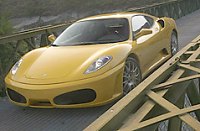 The
stiffer chassis benefits handling. It won't flex or twist under
g-force,
thus allows suspension control to be more accurate. The suspensions
continue
to be all-round double-wishbones, with forged aluminum arms and
electronic-controlled
adaptive dampers. Predictably, wheel and tire sizes are up, as are the
brakes. The difference is now you can opt for the super-powerful
carbon-ceramic
brakes at a price equivalent to a brand-new supermini. Bargain? those
can
afford the Ferrari may think so. The
stiffer chassis benefits handling. It won't flex or twist under
g-force,
thus allows suspension control to be more accurate. The suspensions
continue
to be all-round double-wishbones, with forged aluminum arms and
electronic-controlled
adaptive dampers. Predictably, wheel and tire sizes are up, as are the
brakes. The difference is now you can opt for the super-powerful
carbon-ceramic
brakes at a price equivalent to a brand-new supermini. Bargain? those
can
afford the Ferrari may think so.
To enhance
cornering stability,
a small diameter twin-plate clutch replaced the large single-plate
clutch.
This allows the V8 to be mounted lower in the chassis. After the clutch
is either a conventional 6-speed manual or a 6-speed F1 semi-automatic
transmission (expect 80% customers will choose the latter). The
software
of the F1 box is improved again, enables much smoother gearchange. The
gearbox transmit its power to a new electronic differential called
"E-Diff".
Ferrari claims this technology was transferred from its F1 cars and it
is the world's first for production car. In fact, there is no
fundamental
differences between E-Diff and Mitsubishi's AYC or BMW's Variable
M-differential.
Well, it's a good technology, just don't mention "world's first" or "F1
technology" in every sentence.
The real F1
technology is
"Manettino", a steering wheel-mounted control interface for various
systems.
When the car is as fast as F430, Manettino really relieves the burden
of
the driver and let him concentrate on the road. Behind the Manettino
interface
is the industry's most versatile integrated control system. It offers
the
driver 4 driving modes to choose from - Ice, Damp, Sport and Race.
These
modes alter the setting of the adaptive damping, F1 gearshift response,
throttle response, CST traction and stability control and the setting
of
E-Diff.
On the Road
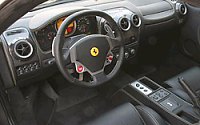 Open
the door, you will see a cabin much different from 360. It still offers
a lot of room, including the storage space behind the seats, but the
ambience
is much more intense, much more race car like. Instead of light-color
leather
trim, the new cabin is trimmed with black leather to match the
cabin-fiber
panels around console and ventilation outlets. The instrument is
dominated
by a big illuminated rev counter. The steering wheel has a simple
rotary
switch - the "Manettino". All things look the business, I mean racing
business.
Gone is the days of luxurious expression. Ferrari is going back to the
no-nonsense era. Open
the door, you will see a cabin much different from 360. It still offers
a lot of room, including the storage space behind the seats, but the
ambience
is much more intense, much more race car like. Instead of light-color
leather
trim, the new cabin is trimmed with black leather to match the
cabin-fiber
panels around console and ventilation outlets. The instrument is
dominated
by a big illuminated rev counter. The steering wheel has a simple
rotary
switch - the "Manettino". All things look the business, I mean racing
business.
Gone is the days of luxurious expression. Ferrari is going back to the
no-nonsense era.
Start
the V8, it
sounds richer,
thicker than the outgoing engine. Being basically a pair of 4-cylinder
engine jointed at a common crankshaft, the flat-crank V8 roars like a
pair
of 4-cylinder engine in sync. It sounds nothing like American or German
V8s, being more hollow, louder and angrier. That makes it immediately
recognizable
through the air.
The
engine is
always torquey.
From just 2000 rpm it already delivers respectable pull, just like what
its predecessor did at 3000 rpm. By 4000 rpm it punches out really
strong
torque, yet this is just halfway of its rev range. The crankshaft spins
freely like without any inertia. The needle passes 5000 rpm, 6000 rpm
and
7000 rpm so quickly. The V8 screams more and more crazily along with
the
rising rev. 8000 rpm, what an additive thunder ! 8500 rpm, some 490
horses
are under your feet ! the pace it delivers is astonishing by production
car standard. Mercedes SL65 ? bye-bye ! you need the world's rarest
supercars
like Enzo, Pagani, Carrera GT or SLR to beat it. Well, Ford GT is
quicker,
but the Ferrari V8 screams so thrilling that you would have believed it
were faster !
Not only in
straight line,
F430 also attacks corner much quicker than the 360. In Fiorano, the 360
was 3 seconds quicker than F355. Now F430 is 3 seconds quicker again.
That
means it trail the Enzo supercar by only 2 seconds a lap.
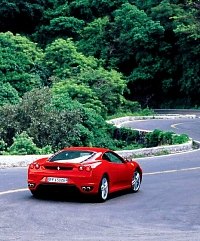 Apart
from speed, you will discover 2 other improvements immediately.
Firstly,
ride is noticeably smoother than 360 and Lamborghini Gallardo.
Secondly,
the F1 gearbox now shifts smoothly, so smooth that few people can
resist
its temptation. Apart
from speed, you will discover 2 other improvements immediately.
Firstly,
ride is noticeably smoother than 360 and Lamborghini Gallardo.
Secondly,
the F1 gearbox now shifts smoothly, so smooth that few people can
resist
its temptation.
What about
steering? many
recent supercars and sports cars let us down in this aspect, such as
Enzo,
Gallardo and Porsche 997. But not the F430. It has one of the most
feelsome
steerings in the world, being light, precise and fully communicative.
It
steers exactly the way as the driver thinks, just like an extension of
his body.
This
is not only
contributed
by the steering rack (which is the same as 360), but also the
electronic
differential. While Gallardo and Ford GT feel somewhat big and clumsy,
F430 feels light and agile. It is the only car out there displaying no
understeer at hard cornering, just pure neutral. There is no scary
oversteer
like the 360 either, because the active differential always send the
right
amount of drive to each rear wheel to correct over/understeer. Praise
must
be given to the F430 engineering team. They resisted the temptation to
follow the safe understeer trend like their competitors. They place
driver
control in first priority. They give the driver the best feedback from
steering, brake pedal and throttle pedal, react the driver's input with
the purest steering, the sharpest throttle response and the strongest
braking
power from the ceramic discs. They made F430 the most involving and
thrilling
car to drive.
Such a pure
character makes
F430 stand out from the crowd. Now the entry-level Ferrari is back to
the
center stage. |
| The
above report was last updated on 1 Feb 2005. All
Rights Reserved. |
The road to higher level
|
With the
vastly
increased power
and performance, the F430 got a price hike of about 6% from 360 Modena.
It costs £117,000 in the UK and US$171,000 in the USA.
Interestingly,
when Ferrari
introduced 206GT in the late 60s, it was deemed to be a rival of
Porsche
911. This did not change much in 308 and 328. Since 348 the V8 line
started
migrating to a higher category. This process accelerated after the
death
of F512M, by then Ferrari no longer had a flagship mid-engined
sports car to sit above the V8 line.
In
the mid-80s,
328 produced
270 horsepower. This increased to 300hp in the 348, 380hp in F355 and
400hp
in 360 Modena. Now F430 gets close to the 500hp territory. Today, the
V8
line no longer competes with Porsche 911 as it costs double the price.
Instead, its biggest rival is Lamborghini Gallardo.
|
| The
above report was last updated on 1 Feb 2005. All
Rights Reserved. |
F430 vs Gallardo
|
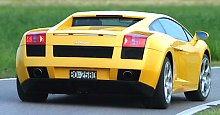 Ford
GT might be faster than the F430, but the only real threat comes from
Lamborghini
Gallardo. The Italian neighbour has been Ferrari's arch-rival since
1963.
Only it has the fame and exotic image to compete with Ferrari. In late
last year, Autocar magazine and Evo magazine compared the F430 and
Gallardo.
The result is summarized below. Ford
GT might be faster than the F430, but the only real threat comes from
Lamborghini
Gallardo. The Italian neighbour has been Ferrari's arch-rival since
1963.
Only it has the fame and exotic image to compete with Ferrari. In late
last year, Autocar magazine and Evo magazine compared the F430 and
Gallardo.
The result is summarized below.
Both cars have
strong engines.
The Ferrari's 4.3-litre V8 is more urgent, with sharper throttle
response
and louder noise. Naturally, the Lamborghini 5.0-litre V10 is more
torquey
and flexible at all rev, this compensates the 70kg extra weight and the
energy loss at the 4WD system. But the Ferrari could be faster when the
driver squeeze its high-revving V8 to the maximum. Subjectively, it
also
feels faster.
In handling,
the
Gallardo
shines only in one area - traction. Its 4WD system is an advantage in
poor
conditions, but it also introduces too much understeer. It feels larger
and bulkier than the Ferrari. The drive to the front wheels also rob
the
steering feel, making it somewhat numb. In contrast, the Ferrari feels
more agile and neutral to handle. On dry surfaces, its E-Diff provides
consistent traction at the rear wheels. Its steering is lighter yet
provides
uncorrupted feel.
However, if
you
enjoy an
effortless drive, Gallardo could be better. Its safe understeer makes
the
car insensitive to surfaces changes or side winds. As a result, it
doesn't
require constant steering correction like the Ferrari.
Both
cars ride
well, but
Gallardo's low speed ride is not as good as F430. Both cars have strong
brakes, but again the Ferrari's optional ceramic discs have the upper
hands
- it is stronger yet completely fade-free.
Overall
speaking,
the Ferrari
is the winner. |
| The
above report was last updated on 1 Feb 2005. All
Rights Reserved. |
F430 vs Ford GT
|
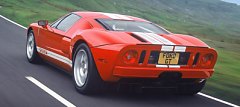 In June
2005, Motor Trend magazine compared the F430 with Ford GT. The
traditionally American car-biased magazine made a very objective
verdict this time. It praised the Ferrari's handling, which is sharper
and goes faster in the twisties than Ford GT. Although the latter has
tremendous grip from its wider tires, the Ferrari's E-diff directs the
right amount of torque to each rear wheel, enabling faster cornering.
This is the first advantage over the GT. In June
2005, Motor Trend magazine compared the F430 with Ford GT. The
traditionally American car-biased magazine made a very objective
verdict this time. It praised the Ferrari's handling, which is sharper
and goes faster in the twisties than Ford GT. Although the latter has
tremendous grip from its wider tires, the Ferrari's E-diff directs the
right amount of torque to each rear wheel, enabling faster cornering.
This is the first advantage over the GT.
Another advantage of F430 is steering. It is very accurate and
communicative, just like a racing car's. In comparison, the GT's
steering is more remote and viscous. In fact, all controls of the
Ferrari are more precise than the Ford's, such as throttle and brake
pedals. Both brakes are powerful, but the Ferrari's carbon ceramic
discs cut 10% stopping distance from the Ford.
Motor Trend found Ford GT's superior torque (+157 lbft) and power (+60
hp) allows it to be driven effortlessly while providing astonishing
acceleration. In straightline, it is faster than the Ferrari once it
regain traction from 50 mph. By 100 mph, it is already leading for half
a second (see table in the following topic).
GT also beats F430 by offering a smoother ride, which is a surprise
considering the Ferrari has adaptive damping. However, it is the
Ferrari that offers the better overall practicality and comfort,
because its cabin is much more spacious (including a crucial 2.4 inch
more headroom), its luggage compartments are truly usable (while GT's
storage space is virtually non-existence), far superior all-round
visibility, ease of access and the automated F1 gearbox.
In terms of desirability, the Ford cannot match the Ferrari of course.
No matter the wide paneling gaps, the poor quality cabin materials and
the mass production switch gears, the Ford does not seem like a car
competing in the same segment as the Ferrari. Yes, it costs 25% less
than the Ferrari, but it loses the traction / stablity control, ceramic
brakes and F1 gearbox. After all, at this price level, a difference of
US$50,000 is not very important to their target customers.
Overall speaking, F430 is the winner. |
| The
above report was last updated on 24 Jun
2005. All Rights Reserved. |
Incredible performance figures
|
In January
2005,
Road &
Track magazine tested a F430 at Fiorano, Ferrari's home test track. It
recorded some astonishing figures: 0-60 mph took 3.5 seconds, 0-100 mph
took 8.1 seconds. That's 0.45 sec and 1.1 sec respectively quicker than
the official claim. That arouse my suspicion immediately. I remember Autocar once
recorded a 360 Modena taking only 8.8 seconds to 100 mph, while other
magazines
found more than 10 seconds. The British magazine therefore suspected
Ferrari
provided a specially prepared test car.
In the same
month, Car And
Driver also tested the F430 at Fiorano. The figures are even slightly
faster
- 3.5 seconds and 7.9 seconds respectively. Car And Driver said their
test
car was not the same one as that tested by a "rival magazine" but the
result
was similar. It also revealed that both magazines tested the car at
Fiorano's
slightly downhill straight runway and not allowed to go in reverse
direction.
This may account for a few tenths for 0-100 mph, but cannot explain the
big difference from the official figures.
Later, Italian magazine Quattroroute recorded similar figures again
(3.55 sec for 0-60 and 8.1 sec for 0-100). Even the usually slow Motor
Trend measured 3.7 sec and 8.3 sec respectively. It seems the F430 is
really that fast !
In fact, the data reveals why it can be so quick: its launch control
gives it a lot of advantage in standstill acceleration, eliminating
initial wheelspin and optimize the rev at which gearchange is made.
Take the Motor Trend's data for example:
|
Ford GT
|
F430
|
| 0-30 mph |
1.7 sec
|
1.3 sec
|
0-40 mph
|
2.4 sec
|
1.9 sec
|
| 0-50 mph |
3.0 sec
|
2.9 sec
|
| 0-60 mph |
3.6 sec
|
3.7 sec
|
| 0-70 mph |
4.5 sec
|
4.5 sec
|
| 0-80 mph |
5.4 sec
|
5.7 sec
|
| 0-90 mph |
6.3 sec
|
6.8 sec
|
| 0-100 mph |
7.8 sec
|
8.3 sec
|
You can see F430 launched to 30 mph in an eye-popping 1.3 sec, quicker
than Ford GT by as much as 0.4 second ! once overcame the wheelspin,
Ford GT used its power and torque advantage to strike back, levelling
the Ferrari at 50 mph and pulling away from 80 mph. To the Ferrari,
rolling acceleration from 50-100 mph is every bit reasonable for its
power-to-weight ratio (which is lower than Ford GT's). The main
contributor to its astonishing acceleration is the super-responsive
initial launch. |
| The
above report was last updated on 24 Jun
2005. All Rights Reserved. |
F430 Spider
|
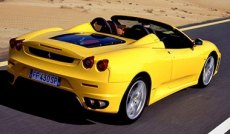 The
Spider version of F430 brings no surprise to us. Its cabriolet stuffs -
the soft top, glass engine lid, semi-flying buttresses and twin-roll bars - are transplanted directly
from
360 Spider to the F430 body. The fabric roof and its electric mechanism
are again made by CTS (Car Top System), the Porsche-owned cabriolet
maker. It
still stores neatly under the hood and takes very little space from the
mid-engined sports car. What make difference is now it takes 20 seconds
to open, versus the previous 28 sec. The
Spider version of F430 brings no surprise to us. Its cabriolet stuffs -
the soft top, glass engine lid, semi-flying buttresses and twin-roll bars - are transplanted directly
from
360 Spider to the F430 body. The fabric roof and its electric mechanism
are again made by CTS (Car Top System), the Porsche-owned cabriolet
maker. It
still stores neatly under the hood and takes very little space from the
mid-engined sports car. What make difference is now it takes 20 seconds
to open, versus the previous 28 sec.
The conversion to cabriolet usually pays price in weight and chassis
rigidity. F430 Spider is no exception. It adds 70 kg to the kerb weight
of F430 Coupe, while chassis rigidity is almost halved*. Anyway, 360
Spider had never been complained for insufficient chassis stiffnes, and
F430
Spider gained another 10% torsional rigidity from it. Suspension setup
is basically identical
to the Coupe, only softer suspension bushings give the Spider a
slightly smoother ride.
 Ferrari
claims near identical performance for the Spider: top speed is 193 mph
(down from 196 mph), 0-100 kph takes 4.1 sec (up from 4.0 sec). Behind
the wheel, this is easily believable. All journalists said that the
car is very quick and shows very little deterioration in handling. Ferrari
claims near identical performance for the Spider: top speed is 193 mph
(down from 196 mph), 0-100 kph takes 4.1 sec (up from 4.0 sec). Behind
the wheel, this is easily believable. All journalists said that the
car is very quick and shows very little deterioration in handling.
But to me, the coupe is still the better choice - stiffer, lighter and
cheaper. The strongest point of Spider is styling - it looks more
exotic than the coupe, and the glass screen showing the
engine is always a stunning feature. Millionaires will prefer the
Spider, while purists will choose the Coupe. Ferrari estimated 55%
customers will be the former.
* Ferrari provides no
figures about chassis rigidity for comparison, but from my new and old
data I can conclude that if the torsional rigidity of 360 Coupe is 100,
then 360 Spider is 60, F430 Spider is 66 and F430 Coupe is 120. The
difference between Coupe and Spider actually grew bigger in F430.
|
| The
above report was last updated on 29 Apr
2005. All Rights Reserved. |
430 Scuderia
|
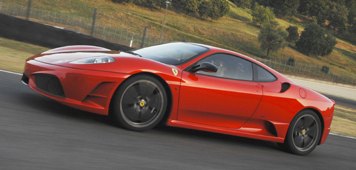
|
Porsche
911 GT2 and Lamborghini Gallardo Superleggera are exciting, but this
Ferrari is simply sensational...
|
Four
years ago, Ferrari introduced the first stripped-out, track-oriented
version of its V8 line, the 360 Challenge Stradale. This car thrilled
car enthusiasts by its sharp handling and strong track performance so
that it immediately became a hit. Having seen its success, Lamborghini
followed suit by introducing the lightweight Gallardo Superleggera. Not
long later, Porsche fought back by upgrading its GT2 to 997-spec. Car
lovers have never been so excited. But the best news still comes from
Maranello: the successor of 360 Challenge Stradale has finally arrived
! It is called 430 Scuderia, where "Scuderia" is the name of the
Ferrari grand prix team since the very beginning. It implies that the
car has strong links with F1 technologies, as we shall see later.
As you would expect for a track-oriented special edition, 430 Scuderia
costs considerably more money than the production F430, i.e.,
£173,000 versus £129,000. Rich guys are unlikely to care
about the difference. What they require is maximum performance and the
most thrilling driving experience, both of which can be found in the
Scuderia.
In fact, from the exterior design you can immediately tell the
difference - the 430 Scuderia has an apparently optimized aerodynamic
package including deeper lip spoilers, reshaped front intakes, extra
side vents, tilter tail spoiler and a more effective diffuser to
produce more downforce. The high-mounted, large-diameter twin-exhaust
(instead of four smaller exhaust pipes) looks purposeful, as do the
blackened door mirrors and tail panel. The new car also looks lower -
you are right, its ride height has been dropped by 15 mm to enhance
stability. If you are a good observer, you may also notice that the
front tires have been widened by 10 mm and the front brakes have been
enlarged from 380 mm to 398 mm. Oh yes, Brembo CCM carbon ceramic discs
and 6-pot aluminum calipers are standard on this car in order to
provide fade-free stopping power while reducing unsprung weight.
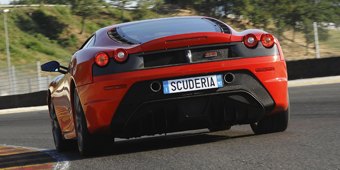
|
Don't fool by its track-car
appearance, the Scuderia is not only faster on track, it is also more
user-friendly on road...
|
Open the door, the lightweight treatment is simply sensational. Apart
from the existing dashboard panels, carbon-fiber is used extensively
for door panels, transmission tunnel, bulkhead, bucket seats and door
mirrors. There is no sound deadening materials, leather or carpet in
the cabin. The floor and door sills expose the bare aluminum chassis
like Lotus Elise. The rear window is made of lightweight Lexan instead
of glass. More weight savings are found outside the cockpit, such as
the carbon-fiber air boxes of the engine, the lighter alloy wheels with
titanium nuts, the aforementioned ceramic brakes, the lighter
twin-exhaust and titanium suspension springs. Overall, the 430 Scuderia
weighs 1350 kg in kerb, some 100 kilograms less than the standard car.
While such reduction is not as impressive as Porsche 911 GT2, you
should understand that the standard F430 already employed a lot of
lightweight materials so that it doesn't offer as much room for
improvement as the case from 911 Turbo to GT2. From this point of view,
the 100 kg reduction is by all means respectable. Most important, it
keeps the Scuderia some 80-90 kg lighter than the GT2 and Lamborghini
Gallardo Superleggera.
However, lightweight alone is not enough. Ferrari also tuned the
4.3-liter V8 to produce more punch. Smoother intake and exhaust and a
higher compression ratio (11.9:1 instead of 11.3:1) made possible by
ion-current knock-sensing technology (like BMW M5 and M3) releases
another 20 horsepower and 4 pound-foot of torque. The power delivery is
not only no peakier than the regular car, but there is actually more
mid-range torque from 3000 to 6000 rpm, surprisingly. In addition to
the lightweight, 430 Scuderia feels more tractable to drive at regular
speed. Up the pace, its fabulous V8 engine sends thundering noise into
the uninsulated cabin and pushes the car to 60 mph in 3.5 seconds. 100
mph can be reached in the high 7-second range – and this can be
consistently repeated because it employs the formula one-inspired
F1-Trac traction control system !
In straight line, the Scuderia is probably no quicker than GT2 and
Superleggera. But to the driver it certainly feels quicker and more
thrilling, thanks to the sensational engine noise and the mind-blowing
F1 Superfast 2 gearbox. Through the years, Ferrari transferred what it
learned from Grand Prix racing to its road-going semi-automatic
transmission. Now it finally delivers what it promised for years –
lightning gearchanges and the sensation of uninterrupted power
delivery. It takes only 60 milliseconds to finish a gearshift, compare
to 150 ms in F430 and 100 ms in 599 GTB. It is also much smoother than
other similar systems, for example, Lamborghini E-gear and BMW SMG.
Yes, Porsche may strike back with a double-clutch gearbox soon, but
even so I doubt whether it can match the speed of F1 Superfast 2.
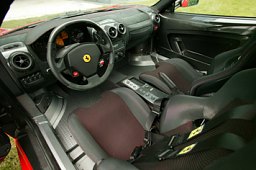
|
For the first time, the Manettino
switch works independently from adaptive damping. It should have been
that from the outset !
|
The lightweight, the beefed up suspensions and brakes, the tuned engine
and the speedy gearshift let 430 Scuderia to lap Ferrari's Fiorano
track in 1 min 25 sec, a full 2 seconds faster than F430. In fact, it
is even faster than the Enzo, believe or not ! Considering that
supercar provided 150 more horsepower, obviously, 430 Scuderia needs to
be very good in handling to beat it.
Yes, it is. Many regards this as the best chassis Ferrari has ever
produced, one that even surpasses 599 GTB. Its balance, its neutrality,
its grip and its braking are all beyond the level of F430. The wider
front rubbers add front-end bite and eliminate the slight understeer
associated with the standard car. The lightweight steering might lack
the tactile feel of Porsche, but it is undoubtedly accurate and very
responsive. The electronic brains in this car work so well to assist
the driver without feeling artificial. The E-diff active rear
differential now integrates with F1-Trac traction control to distribute
the right amount of power to each rear wheel. As a result, the Scuderia
is incredibly stable at the limit. It won't threaten its driver by
kicking out the tail suddenly as in GT2 and Superleggera. It gives its
driver full confidence to exploit its talent. It delivers an intimate
feel lacking in its rivals. You can find a similar feel in Lotus Elise
or Porsche GT3, but this is the first time a supercar at this
performance level is associated with this feel.
Surprisingly, 430 Scuderia is also a better day-to-day companion than
F430 as well as its arch-rivals. This is contributed by the torquer
engine, the smoother gearshift and the possibility of setting adaptive
damping independent of the Manettino dynamic control (which alters
throttle response, transmission response, active differential and
traction control). Leave the suspension at Comfort mode and you will
find the ride is incredibly agreeable.
So 430 Scuderia is an amazing car, one that delivers giant-killing
performance in the real world, one that really gels with its driver and
one that usable as a daily car. Perhaps Enzo Ferrari was wrong. Now the
best Ferrari is back to the mid-engined camp. |
| The
above report was last updated on 17 Oct
2007. All Rights Reserved. |
|
|